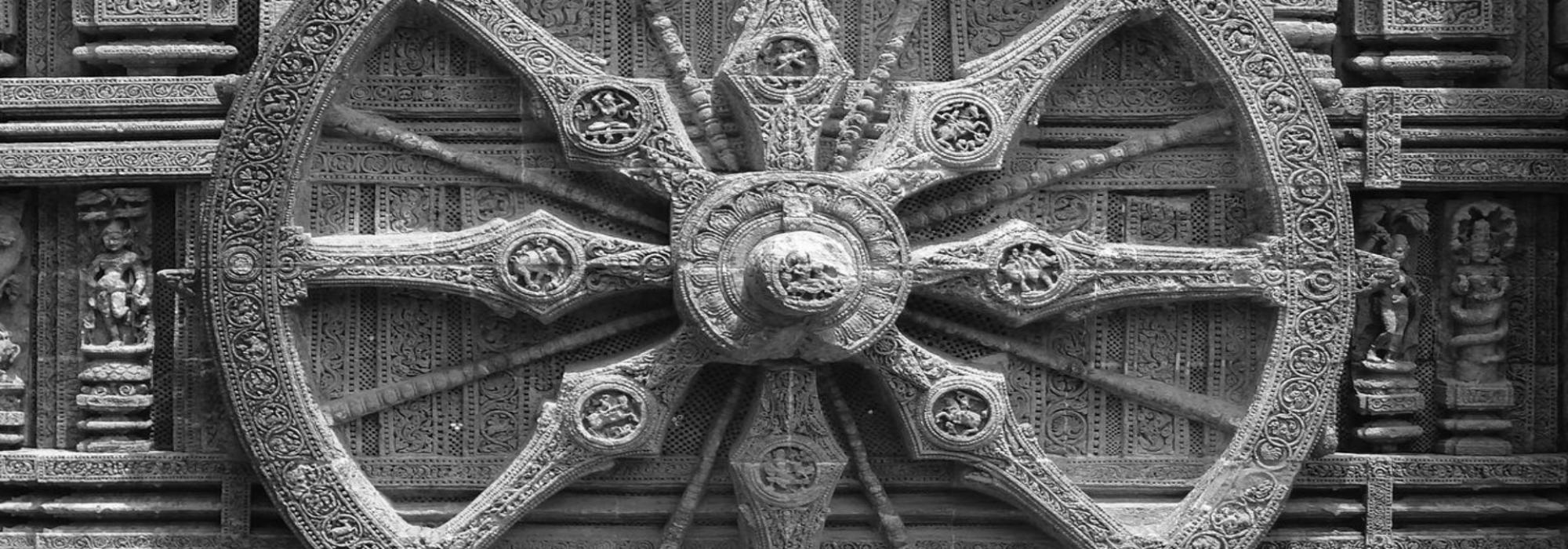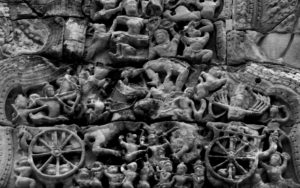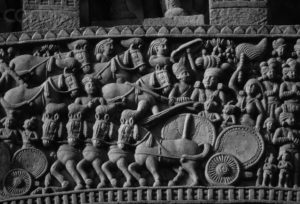The personalities of Chanakya and Chandragupta were of similar eminence, similar spirit; the supreme testimony to this fact is that such a large empire was managed efficiently for several years and the onslaught of the ambitious, war-hungry Alexander was quelled without leaving even a trace of its memory. From this we learn how sharp their developmental strategy must have been. We see how bright that patriotism must have been, which found inspiration from their strong sense of identity. In the Mudrārākṣasa, a chamberlain named Vaihinari sees Chanakya’s hut and exclaims subtly, "अहो महामात्यस्य विभूतिः!" (“Oh look at the wealth of the Prime Minister!”). And how was his hut?
upalaśakalametadbhedakaṃ gomayānāṃ
vaṭubhirupahṛtānāṃ barhiṣāṃ stūpametat |
śaraṇamapi samidbhiḥ śuṣyamāṇābhirābhi-
rvinamitapaṭalāntaṃ dṛṣyate jīrṇakuḍyam ||
(Mudrārākṣasa 3.15)
At one end, there’s a stone to break cow dung lumps
At another, a heap of darbha grass brought by young brahmacāris (students)
At yet another end, a roof that is bent owing to the piling up of samidhs (firewood)
and due to this, the old walls slipping down.(Lumps of cow dung are made into balls and dried; these are called ‘mūḍha.’ If these are put into the fire pit at night, they burn slowly and steadily giving warmth; this also helps retain the fire all through. The next morning, by the time the āhuti, i.e. the offering, has to be given, one can rekindle the fire easily. The stone that is used to break such mūḍhas is called upalaśakala.)
Such is Chanakya’s house. This is the grandeur of the residence of the Prime Minister! It is for this reason he can speak his mind without hesitation to Chandragupta, the great emperor among kings. He speaks to the emperor in the singular, in a familiar tone, alluding to his caste, and in a commanding manner. To behave in this way, one has to be absolutely selfless, brilliant, and endowed with sincere love. People might be selfless but not particularly intelligent; thus they are "hitaiṣiṇaḥ kiṃ tu na te manīṣīṇaḥ." There are others who might be brilliant but not particularly selfless; thus they are "manīṣīṇaḥ kiṃ tu na te hitaiṣiṇaḥ." But one needs to be both. Awareness and Love should abound. We see that Chanakya had both. The story of Chanakya and Chandragupta as well as the strategies and counter-strategies of Chanakya and Amatyarakshasa are not merely the imagination of Vishakhadatta. It has been recorded in texts like Kathāsaritsāgara, Bṛhatkathāmañjarī, Bṛhatkathāślokasaṅgraha, Mahāvaṃśa, Pariśiṣṭaparva, Viṣṇupurāṇa, and Bhaviṣyapurāṇa in varying degrees of detail.
In more recent renderings of the ancient text Bṛhatkathā—which has been lost today—we find that Rakshasa, i.e. Vararuchi Katyayana, was the minister of the Nandas. Chanakya once again appointed him as the prime minister of the Magadha empire. Thus, brāhma’s support for kṣātra may come from any source and that should be embraced; the establishment should be made reliable and good. After Chandragupta becomes the emperor of the kingdom, Chanakya creates several practices in the Arthaśāstra. And he records all those practices in his treatise, the Arthaśāstra. When we see the manner in which he has clearly stated this at the end of the treatise, it becomes clear to us that none of these came into being without experience, without actually experimenting with it and honing it. He says, “येन शस्त्रं च शास्त्रं च नन्दराजगता च भूः । अमर्षोणोद्धृतान्यासन् तेन शास्त्रमिदं कृतम् ॥” (Kārikā 382) – here, weapons (śastra) are strength, land (bhūḥ) is the resource; śāstra is deliberation. What is the fate of that kingdom that falls into the hands of an evil king who has the intelligence to subdue the freedom of the subjects, the strength to drive fear into their hearts, the ability to render them helpless and without support, the capacity to make anyone do anything for him, and the resources to plan and execute devious schemes to lure anyone? When King Dhanananda became this sort of evil emperor, Kautilya [another name of Chanakya], merely by the force of his anger, brought about the downfall of the Nandas; it was such a person who composed the Arthaśāstra– he himself says this in the treatise, and it is true.
“सर्वशास्त्राण्यनुक्रम्य प्रयोगमुपलभ्यता । कौटिल्येन नरेन्द्रार्थे शासनस्य विधिः कृतः ॥” (Kārikā 79). (Having observed several branches of learning—not merely Arthaśāstra—including Veda, Nyaya, Dharmaśāstra, Gemology, study of horses, study of elephants, study of plants and medicine, and hundreds of other subjects – and having seen their grammars,
I have made this śāstra with all its rules and prescriptions for the all-round development of the king.) “सुखग्रहणविज्ञेयं तत्त्वार्थपदनिश्चितम् । कौटिल्येन कृतं शास्त्रं विमुक्तग्रन्थविस्तरम् ॥” (Kārikā 1) (Kautilya has written the Arthaśāstra in an instructive manner with great clarity of concepts, without ambiguity, and without too much elaboration (i.e. in a succinct manner) in about 380 kārikās, which roughly amounts to 6,000 granthas (where a grantha refers to a set of thirty-two letters). This is not merely the imagination of a creative person. Historians too have provided ample evidence for this.
In matters related to Chanakya, I have gone through not only the primary sources but also the meticulous research of later scholars like R Shamashastry, T Ganapati Sastri, R P Kangle, Radhakumud Mukherjee, and K P Jayaswal. Therefore, these words are not baseless hagiographical pronouncements. Further, the supporting wall for this entire work has primarily been the eleven-volume series, The History and Culture of Indian People edited by Ramesh Chandra Majumdar and published by the well-known cultural organization Bharatiya Vidya Bhavan under the able guidance of K M Munshi. The Bangalore branch of the Bhavan produced an eminently readable Kannada translation of the magnum-opus. The Kannada translation was published in twenty-five volumes under the editorship of Prof. A V Narasimhamurthy. I have gone through that work as well and used that as a source. Therefore, my words are motivated by neither monastery nor sect nor any fundamentalist organization – none need to make a hue and cry about it. Apart from this remarkable series published by the Bhavan, there has been no other work so far on Indian history that is so expansive and profound. Therefore this work has gained prominence. Nearly fifty great scholars of that era came together to produce this eleven-volume masterpiece. It is only the first volume of the work – The Vedic Age – that needs to be revised quite a bit; the rest of the volumes are largely free of error.
Kautilya says, If foreigners invade us, they typically loot the wealth of our country – “अपवाहयन्तम् कर्षयन्ति च.” On the one hand, they loot the country; on the other hand, having established their sovereignty over the land, they inflict atrocities upon the people in a methodical, systemic manner—using the establishment—by various means including the collecting of taxes. They run a campaign of plunder; as soon as the war ends, they conduct several raids in the country. The soldiers are given a free hand to devour whatever they can lay their hands on. Then the emperor tells the people, “Let’s set things right!” and sets up an agreement: You accept our overlordship, thus establishing their reign. Soon taxes and the like are hurled upon the defeated people and a variety of atrocities are perpetrated upon them. अपवाहयन्तम् means ‘they devour’ and कर्षयन्ति means ‘they harass through taxes and the like.’
If we are to avoid such calamities, we need our own local ruler, Kautilya says. After the destruction of the [Northwestern] kingdoms by Alexander, the country needed support and hope; that was made possible by Chanakya. Not only did he establish such a kingdom but he went on to defeat Seleucus Nicator who represented Alexander in India. He also established friendly relations with the leaders and the people of Himalayan tribes. We find references to this in the Jaina work, Pariśiṣṭaparva. We learn from the Mudrārākṣasa and other works about his connections
with Parvataka, a mountain king. Chandragupta Maurya not only re-conquered the parts of Northwestern India (i.e. a large portion of today’s Pakistan) that had been ravaged by the Greeks but also married Helena, the daughter of Seleucus Nicator, Alexander’s general; we find references for this in a few places. After destroying the enemy, to ensure that no further quarrel arises with them, an alliance of marriage is a great strategy; it only strengthens the bond between the kingdoms. Chandragupta ruled the kingdom for about twenty-four years. During his regime, people were all well-fed and lived a good quality of life – such was the political establishment. After him, the one who ascended the throne was his son Bindusara.
History doesn’t have much to say about Bindusara’s achievements. But we learn a great deal about his son Ashoka’s life and deeds. The voice of the Greeks was largely subdued by the valour of Chandragupta Maurya. They went off to distant Bahlika (Bactria) and settled there. [Bahlika is an ancient settlement that lay between the Hindukush mountains and the river Amu Darya.] It is said that Megasthenes visited the court of Chandragupta. But there is much debate about it among scholars. In sum, it is important to recognize that the foreign invaders were defeated and came under the scepter of King Chandragupta Maurya.
To be continued...
Translated from Kannada by Hari Ravikumar. Translator's notes in square brackets.



















































